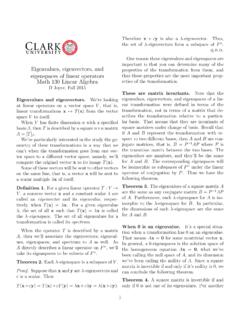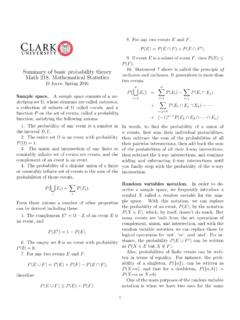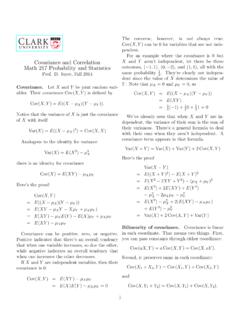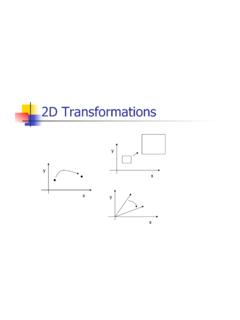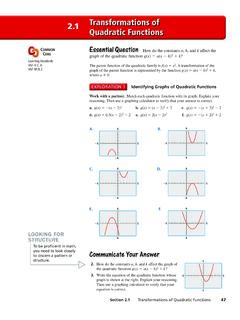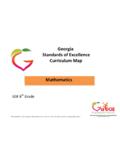Transcription of Some linear transformations on R2 Math 130 Linear Algebra
1 Some Linear transformations onR2 Math 130 Linear AlgebraD Joyce, Fall 2015 Let s look at some some Linear transformations on the planeR2. We ll look at severalkinds of operators onR2including reflections, rotations, scalings, and ll illustrate these transformations by applying them to the leaf shown in figure 1. Ineach of the figures thex-axis is the red line and they-axis is the blue 1: Basic leafFigure 2: Reflected acrossx-axisExample 1(A reflection).Consider the 2 2 matrixA=[100 1]. Take a generic pointx= (x,y) in the plane, and write it as the column vectorx=[xy]. Then the matrix productAxisAx=[100 1][xy]=[x y]Thus, the matrixAtransforms the point (x,y) to the pointT(x,y) = (x, y).
2 You ll recognizethis right away as a reflection across is special to this operator as it s the set of fixed points. In other words,it s the 1-eigenspace. They-axis is also special as every point (0,y) is sent to its negation (0,y). That means they-axis is an eigenspace with eigenvalue 1, that is, it s the 1-eigenspace. There aren t any other eigenspaces. A reflection always has these two eigenspacesa 1-eigenspace and a 2 2 matrix describes some kind of geometric transformation of the plane. Butsince the origin (0,0) is always sent to itself, not every geometric transformation can bedescribed by a matrix in this 2(A rotation).
3 The matrixA=[0 110]determines the transformation that sendsthe vectorx=[xy]to the vectorx=[ yx]. It determines the Linear operatorT(x,y) =( y,x). In particular, the two basis vectorse1=[10]ande2=[01]are sent to the vectorse2=[01]ande2=[ 10]respectively. Note that these are the first and second columns ofA. You ll recognize this transformation as a rotation around the origin by 90 . (As always,the convention is to always take counterclockwise rotations to be by a positive number ofdegrees, but clockwise ones by a negative number of degrees.)There are no eigenvalues for this rotation. There are no nontrivial eigenvectors at all.
4 (We don t consider0since it s always sent to itself.) If, however, you use complex scalars,there is one. The vector (1, i) is sent to (i,1), so it s ani-eigenvector, and (1,i) is sent to( i,1), so it s a i-eigenvector. We ll look at complex eigenvalues later when we study linearoperators in 3: Rotated 90 Figure 4: Rotated 10 Figure 5: Reflected acrossthe liney=xExample 3(Other rotations).Rotations by other angles can be described with the helpof trig functions. The matrix[cos sin sin cos ]describes a rotation of the plane by an angleof .For example, the matrix that describes a rotation of the plane around the origin of 10 counterclockwise is[cos 10 sin 10 sin 10 cos 10 ]=[ ]since sin 10 = andcos 10 = that for any rotation, any circle centered at the origin is invariant.
5 A set is said tobeinvariantunder a transformation if it is sent to itself. The individual points in the setmay be moved, but they must stay within the rotations and reflections preserve distance. That means that the distance betweenany two vectorsvandwis the same as the distance between their imagesAvandAw. Suchtransformations are calledrigid 4(Other reflections).We ve already seen that the matrix[100 1]describes areflection across thex-axis. Likewise,[ 1 001]describes a reflection across they-axis. There sa 2 2 matrix for reflection across any line through the origin. What matrix describes areflection across the liney=x?
6 What are the eigenspaces for this reflection?Example 5(Expansions).Not all Linear operators preserve distance. For instance, contrac-tions and expansions don t. The matrix[2 00 2]sends a vector[xy]to the vector[2x2y]Thus,every point is sent twice as far away from the origin. That s an expansion by a factor of that every vector is a 2-eigenvector. In other words, all ofR2is the 6: ExpansionFigure 7: ContractionFigure 8: Half turnAscalar matrixis a multiple of the identity matrix like this one was. If is a scalar, then I= [1 00 1]=[ 00 ]is a scalar matrix with scalar .Every scalar matrix where the scalar is greater than 1 describes an 6(Contractions).
7 When the scalar is between 0 and 1, then the matrix describes acontraction. For instance[.500 ]moves vectors toward the origin half as far away as wherethey 7(Point inversion half turn).The particular scalar matrix[ 100 1]sendsa point to the other side of the origin, but the same distance away from the origin. That sthe same as a 180 rotation. This operation is called ahalf turnorpoint scalar matrices with negative scalars describe transformations that can be thoughtof as compositions of point inversions and either expansions or the terms dilation and dilatation is used for any of these transformationsdetermined by scalar 8(Projections).
8 Consider the 2 2 matrix[1 00 0]. It sends the vector[xy]to thevector[x0]. This particular transformation is a projection from 2-space onto thex-axis thatforgets they-coordinate. Projections have 1-eigenspaces and 0-eigenspaces. What are theyfor this projection?This projection will map our leaf to thex-axis as shown in figure 9(Shear transformations ).The matrix[1 10 1]describes a shear transformation that fixes thex-axis, moves points in the upper half-plane to the right, but moves points inthe lower half-plane to the general, a shear transformation has a line of fixed points, its 1-eigenspace, but no othereigenspace.
9 Shears are deficient in that that any line parallel to the line of fixed points is invariant under the shear 9: Projection tox-axisFigure 10: A shear transformationExample 10(Stretch and squeeze).Another interesting transformation is described by thematrix[200 ]which sends the vector[xy]to the vector[ ]. The plane is transformedby stretching horizontally by a factor of 2 at the same time as it s squeezed vertically. (Whatare its eigenvectors and eigenvalues?)For this transformation , each hyperbolaxy=cis invariant, wherecis any last two examples are plane transformations that preserve areas of figures, but don tpreserve you randomly choose a 2 2 matrix, it probably describes a Linear transformation thatdoesn t preserve distance and doesn t preserve area.
10 Let s look at one more example beforeleaving dimension 11: Stretch and squeezeFigure 12: A rotary contractionExample 11(Rotary contraction).If you compose a rotation and a contraction, you geta rotary contraction. The matrix[cos sin sin cos ]describes a rotation about the origin byan angle of , while the matrix[.500 ]contracts the plane toward the origin by12, so theproduct of the matrices[ cos sin sin cos ]describes the composition of contracting androtating. (In this case, the order of composing them doesn t matter since the two operationscommute, but usually order makes a difference.) The result is a kind of spiral you take any pointxand repeatedly apply this transformation , the orbit that is producedis a spiral toward the spirals whose equations in polar coordinatesr=c2 2 / are invariant subsetsof this rotary contraction, wherecis any of 3 3 matrix describes a transformation of space, that is, a3-D operator.
